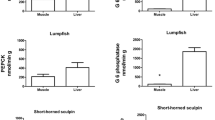Summary
-
1.
The effect of excess adrenaline in the body on blood glucose was worked out at different temperature ranging from 15° to 45° C. A comparatively delayed action of adrenaline preparations was observed in Uromastyx reaching for example 3 hours at 20° C. This delay is shortened to half an hour at 45° C.
-
2.
A relation occurs between the dose of adrenaline administered in the body and the magnitude and duration of hyperglycemia produced.
-
3.
The rate of disposal of glucose from the blood stream after the injection of either glucose or adrenaline is very comparable. This indicates that the mechanism responsible for removal of excess glucose from the blood is the same irrespective of the factors causing the hyperglycemia.
-
4.
After adrenaline administrations, a decrease in glycogen content was observed in liver, skeletal muscles, mucosal part of the stomach, gonads and peritoneal sacs. A comparable increase in glycogen content of the tissues of lung, heart, kidney, plain muscle, brain and in glucose content of blood occurs.
-
5.
The time of action of adrenaline varies according to the mode and site of introduction of the hormone into the body. Thus intrathoracic injections have comparatively faster action than intra-abdomenal ones. It was also found that, the longer the period during which adrenaline is introduced into the body, the more effective it is on the glycogen content of the different tissues.
Similar content being viewed by others
Bibliography
Best, C. L., and N. S. Taylor: Physiological basis of medical practice, 5th edit. London 1950.
Cori, C. F., and G. T. Cori: The mechanism of epinephrine action. The influence of epinephrine on lactic acid production and blood sugar utilisation. J. biol. Chem. 84, 683 (1929).
— —, and K. W. Buchwald: The mechanism of epinephrine action. Changes in blood sugar, lactic acid, and blood pressure during continuous intravenous injection of epinephrine. Amer. J. Physiol. 93, 273 (1930).
Coulson, R. A., and T. Hernandez: Glucose studies in crocodilia. Endocrinology 53, 311 (1953).
Good, C. A., H. Kramer and M. Somogyi: Pflüge'rs method for glycogen determination. J. biol. Chem. 100, 485 (1933).
Hroussay, B.A., and E. Bendetto: Rôle de l'hypophyse dans les hyperglycémies adrenalique et morphinique du crapauds. C. R. Soc. Biol. (Paris) 91, 472 (1932).
Khalil, F., and M. Yanni: Studies on carbohydrates in reptiles. I. Glucose in body fluids of Uromastyx aegyptia. Z. vergl. Physiol. 42, 192 (1959).
Kiermer, A.: Über den Blutzucker der Süßwasserfische. Z. vergl. Physiol. 27, 460 (1959).
Prado, J. L.: Effect of adrenaline and insulin on the blood sugar of Ophidia. Rev. canad. Biol. 6, 2 (1947).
Author information
Authors and Affiliations
Rights and permissions
About this article
Cite this article
Khalil, F., Yanni, M. Studies on carbohydrates in reptiles. Z. Vergl. Physiol. 44, 363–370 (1961). https://doi.org/10.1007/BF00388035
Received:
Issue Date:
DOI: https://doi.org/10.1007/BF00388035




